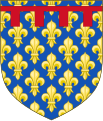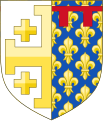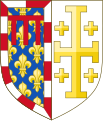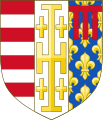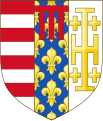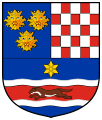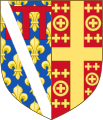Capetian House of Anjou
| House of Anjou | |
|---|---|
 Arms of the Capetian House of Anjou | |
| Parent house | Capetian dynasty |
| Country | Kingdom of France, Kingdom of Sicily, Kingdom of Naples, Kingdom of Hungary, Kingdom of Poland, Kingdom of Croatia, Kingdom of Albania, Principality of Albania, Principality of Achaea |
| Founded | 1246 |
| Founder | Charles I of Naples |
| Final ruler | Joanna II of Naples |
| Titles |
|
| Dissolution | 1435 |
| Cadet branches | |
The Capetian House of Anjou, or House of Anjou-Sicily, or House of Anjou-Naples was a royal house and cadet branch of the Capetian dynasty. It is one of three separate royal houses referred to as Angevin, meaning "from Anjou" in France. Founded by Charles I of Anjou, the youngest son of Louis VIII of France, the Capetian king first ruled the Kingdom of Sicily during the 13th century. The War of the Sicilian Vespers later forced him out of the island of Sicily, leaving him with the southern half of the Italian Peninsula, known as the Kingdom of Naples. The house and its various branches would go on to influence much of the history of Southern and Central Europe during the Middle Ages until it became extinct in 1435.
Historically, the house ruled the Counties of Anjou, Maine, Touraine, Provence and Forcalquier; the Principalities of Achaea and Taranto; and the Kingdoms of Sicily, Naples, Hungary, Croatia, Albania and Poland.
Rise of Charles I and his sons

A younger son of the House of Capet king Louis VIII of France the Lion, Charles was first given a noble title by his brother, Louis IX of France who succeeded to the French throne in 1226. Charles was named Count of Anjou and Maine; the feudal County of Anjou was a western vassal state of the Kingdom of France, which the Capetians had wrested from the House of Plantagenet only a few decades earlier. Charles married an heiress of the County of Provence named Beatrice of Provence. She was a member of the House of Barcelona; this meant Charles' holdings were growing as Count of Provence. After fighting in the Seventh Crusade, Charles was offered the Kingdom of Sicily by Pope Clement IV. At the time this included not only the island of Sicily but also the southern half of the Italian Peninsula. Pope Clement IV offered it to Charles because of a conflict between the papacy and the Holy Roman Empire, and the latter was represented by the ruling House of Hohenstaufen.[citation needed]
It was at the Battle of Benevento that the Guelph Capetians gained the Sicilian kingdom from the Ghibelline Swabians, this was cemented after victory at Tagliacozzo. In keeping with the political landscape of the period, Charles is described by scholars as shrewd, energetic and highly ambitious. He signed the Treaty of Viterbo in 1267 with Baldwin II of Courtenay and William II of Villehardouin,[1] the political alliance gave many of the rights of the Latin Empire to Charles and a marriage alliance for his daughter Beatrice of Sicily.[2] The Byzantines had taken back the city of Constantinople in 1261 and this was a plan to take it back from Michael VIII Palaiologos.[2] It also recognised Charles' possession of Corfu and cities in the Balkans such as Durazzo, as well as giving him suzerainty over the Principality of Achaea and sovereignty of the Aegean islands aside from those already held by the Republic of Venice.[3][4] For a while Charles was preoccupied helping his French brother in the unsuccessful Eighth Crusade on Tunis. After this he once again focused on Constantinople, but his fleet was wrecked in a freak storm off the coast of Trapani.[5] With the elevation of Pope Gregory X, there was a truce between Charles and Michael in the form of the Council of Lyons, as Christians focused on improving ecumenical relations, with hopes of regaining the Kingdom of Jerusalem back from the Muslims.[5]
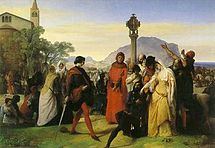
Charles had fully solidified his rule over Durazzo by 1272, creating a small Kingdom of Albania for himself, out of previously Despotate of Epirus territory; he was well received by local chiefs.[6]
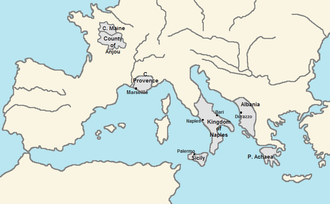
Charles's regime was driven out of Sicily after Sicilian Vespers in 1282,[7] but his house ruled Naples until 1435, when René of Anjou inherited the kingdom.[8]
Charles II and division of the inheritance
This House of Anjou included the branches of Anjou-Hungary, which ruled Hungary (1308–1385, 1386–1395) and Poland (1370–1399), Anjou-Taranto, which ruled the remnants of the Latin Empire (1313–1374) and Anjou-Durazzo, which ruled Naples (1382–1435) and Hungary (1385–1386).
The senior line of the House of Anjou-Durazzo became extinct in the male line with the death of King Ladislaus of Naples in 1414, and totally extinct with the death of his sister Joanna II in 1435.
Cadet branches
Hungary
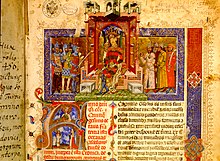
During the Middle Ages, there were several marriages between the Árpád dynasty and the House of Capet. Charles I, founder of the House of Anjou-Sicily, with his first wife, Beatrice of Provence fathered his eldest son, Charles II of Naples. (Their youngest daughter, Elizabeth was given in marriage to the future Ladislaus IV of Hungary in 1269, but Ladislaus preferred his mistresses to her, and the marriage remained childless). In 1270, Charles II married Mary of Hungary, daughter of Stephen V of Hungary and Elizabeth the Cuman. They had fourteen children which provided the House of Anjou-Sicily with a secure position in Naples.
The childless Ladislaus IV of Hungary (1262–1290), was succeeded by Andrew III as King of Hungary. He was the son of Stephen the Posthumous, considered by Stephen's much older half-brothers (Béla IV of Hungary, Coloman of Halych, Andrew II of Halych) a bastard son of infidelity. For this reason, after the death of Ladislaus IV. some of the Árpád dynasty's cognates sought the family as extinct. In Naples, Charles Martel of Anjou, the eldest son of Mary of Hungary announced his claim to the Hungarian crown, backed by his mother, and the Pope. He started to style himself King of Hungary, but he never managed to gain enough support from the Hungarian magnates to realize his claim.
With Andrew III's childless death (1301), the "last golden branch" of the tree of King Saint Stephen's family ended. The Hungarian diet was determined to keep the blood of Saint Stephen (first king of Hungary) on the throne in the maternal line at least. In the upcoming years, a civil war followed between various claimants to the throne. After the short period of rule of Wenceslaus of Bohemia (1301–1305), and Otto of Bavaria (1305–1307) the civil war ended with Charles Robert's (1308–1342) victory, the son of Charles Martel of Anjou, but he was forced to continue fighting against the powerful Hungarian lords up to the early 1320s.
I. Charles I of Anjou 1226/7–1285 king of Sicily(-Naples) = Beatrice of Provence
- II. Blanche (died 1269) = Robert lord of Béthune
- II. Beatrice 1252–1275 = Philip titular Latin Emperor of Constantinople
- II. Elisabeth 1261–1303 = Ladislaus IV of Hungary
- II. Charles II of Naples the Lame 1254–1309 = Mary of Hungary
- III. Charles Martel (1271–1295), titular King of Hungary = Clemence of Austria
- IV. Charles I (1288–1342), King of Hungary = 1. Maria of Galicia (?), 2. Mary of Bytom, 3. Beatrice of Luxembourg, 4. Elisabeth of Poland
- V. (1.) Catherine (died 1355) = Henry II, Duke of Świdnica
- V. (4.) Charles (1321–1321/3)
- V. (4.) Ladislaus (1324–1329)
- V. (4.) Louis I of Hungary (1326–1382) = 1. Margaret of Bohemia, 2. Elizabeth of Bosnia
- VI. (2.) Catherine (1370–1378)
- VI. (2.) Mary of Hungary 1371–1395 = Sigismund of Luxembourg
- VI. (2.) Jadwiga of Poland 1373/4–1399 = Władysław II Jagiełło
- V. (4.) Andrew, Duke of Calabria (1327–1345) = Joanna I of Naples
- VI. Charles Martel, Duke of Calabria (1345–1348)
- V. (4.) Elizabeth (?) (b. 1327/1332) = Boleslaus II of Troppau
- V. (4.) Stephen (1332–1354) duke of Slavonia = Margaret of Bavaria
- VI. Elizabeth 1352–1380 = Philip II, Prince of Taranto, titular Emperor of Constantinople
- VI. John (1354–1360), duke of Croatia, Dalmatia and Slavonia
- V. Coloman (1317–1375), Bishop of Győr – illegitimate son with daughter of Gurke Csák
- IV. Beatrice (1290–1354) = Jean II de La Tour du Pin, Dauphin du Viennois
- IV. Clementia of Hungary (1293–1328) = Louis X of France
- IV. Charles I (1288–1342), King of Hungary = 1. Maria of Galicia (?), 2. Mary of Bytom, 3. Beatrice of Luxembourg, 4. Elisabeth of Poland
- III. Margaret (1273–1299) = Charles of Valois
- III. Saint Louis of Toulouse (1274–1298), Bishop of Toulouse
- III. Robert the Wise (1275–1343), King of Naples = 1. Yolanda of Aragon, 2. Sancia of Majorca
- IV. (1.) Charles (1298–1328), Duke of Calabria, Viceroy of Naples = 1. Catherine of Habsburg (1295–1323), 2. Marie of Valois (1309–1332)
- V. (2.) Eloisa (1325–1325)
- V. (2.) Joanna I of Naples (1326–1382) = Andrew, Duke of Calabria (1327–1345)
- V. (2.) Charles Martel (1327–1327)
- V. (2.) Maria of Calabria (1329–1366) = 1. Charles, Duke of Durazzo 2. Robert of Baux, Count of Avellino 3. Philip II, Prince of Taranto
- IV. (1.) Louis (1301–1310)
- IV. (i.) Charles d'Artois c. 1300–1346, grand chamberlain for Queen Joanna I – illegitimate with Cantelma Cantelmo
- IV. (i.) Maria d'Aquino (Boccaccio's Fiammetta) – illegitimate
- IV. (i.) Hélène of Anjou (13??–1342), Countess of Mat – illegitimate = Andrea I Thopia, Count of Mat
- V. Karl Thopia (1331–1388), Prince of Albania = Voisava Balsha
- VI. Gjergj Thopia (fl. 1388 – d. 1392), Prince of Albania and Lord of Durrës = Teodora Branković
- VI. Helena Thopia (fl. 1388 – 1403), Princess of Albania and Lady of Krujë = 1. Marco Barbarigo, 2. Kostandin Balsha
- VI. Voisava Thopia, Princess of Albania and Lady of Lezhë = 1. Lord Isaac Cursachio, 2. Progon Dukagjini
- VI. (i.) Niketa Thopia (fl. 1388 – d. 1415), Lord of Krujë after capturing the city from his half-sister Helena[9] illegitimate = Komnen Arianiti's daughter
- VI. (i.) Maria Thopia, Baroness of Botrugno illegitimate = Filippo Maramonte
- V. Karl Thopia (1331–1388), Prince of Albania = Voisava Balsha
- IV. (1.) Charles (1298–1328), Duke of Calabria, Viceroy of Naples = 1. Catherine of Habsburg (1295–1323), 2. Marie of Valois (1309–1332)
- III. Philip I 1278–1331, Prince of Taranto and Achaea = 1. Thamar Angelina Komnene 2. Catherine of Valois–Courtenay
- IV. (1.) Charles of Taranto 1296–1315, vicar of Romania
- IV. (1.) Joan of Anjou 1297–1323 = 1.Oshin of Armenia 2. Oshin of Korikos
- IV. (1) Margarete 1298–1340 = Walter VI, Count of Brienne titular duke of Athens
- IV. (1.) Philip, Despot of Romania 1300–1330 = Violante (daughter of James II of Aragon)
- IV. (1.) Maria 1301/4–1368, abbess in Conversano
- IV. (1.) Blanche 1309–1337 = Ramon Berenguer infante of Aragon, count of Prades (son of James II of Aragon)
- IV. (1.) Beatrice = Walter II of Brienne.
- IV. (2.) Margaret c. 1325–1380 = Francis de Baux duke of Adria
- IV. (2.) Robert, Prince of Taranto 1326–1365, titular Latin emperor of Constantinople
- IV. (2.) Louis, Prince of Taranto 1327/8–1362, king of Naples as husband of Joanna I of Naples
- IV. (2.) Philip, Prince of Taranto 1329–1374, prince of Achaea, titular Latin emperor of Constantinople = 1. Maria of Calabria 2. Elisabeth of Slavonia
- III. Blanche of Anjou (1280–1310) = James II of Aragon
- III. Raymond Berengar (1281–1307), Count of Provence, Prince of Piedmont and Andria = Margaret of Clermont
- III. John (1283–1308), a priest
- III. Tristan (1284–bef. 1288)
- III. Eleanor of Anjou, (1289–1341) = Frederick III of Sicily
- III. Maria of Naples (1290–c. 1346) = 1. Sancho I of Majorca, 2. Jaime de Ejerica
- III. Peter Tempesta (1291–1315), Count of Gravina
- III. John (1276–1335), Duke of Durazzo, Prince of Achaea, and Count of Gravina = 1. Matilda of Hainaut (1293–1336), 2. Agnes of Périgord (d. 1345)
- IV. (2.) Charles, Duke of Durazzo (1323–1348) = Maria of Calabria
- V. Joanna, Duchess of Durazzo 1344–1387 = 1. Louis, Count of Beaumont 2. Robert IV of Artois, Count of Eu
- V. Agnes of Durazzo 1345–138 = Cansignorio della Scala lord of Verona 2. James of Baux
- V. Margaret of Durazzo 1347–1412 = Charles III of Naples
- IV. (2.) Louis, Count of Gravina (1324–1362) = Margaret of Sanseverino
- V. Louis (1344–d. young)
- V. Charles III (1345–1386), king of Naples (1382–1386) and Hungary (1385–1386) = Margaret of Durazzo
- VI. Joanna II of Naples 1371–1435 = 1. William, Duke of Austria 2. James II, Count of La Marche
- VI. Ladislaus of Naples 1377–1414 = 1. Costanza Chiaramonte, 2. Mary of Lusignan, 3. Mary of Enghien
- V. Agnes (1347–d. young)
- IV. (2.) Robert of Durazzo (1326–1356)
- IV. (2.) Charles, Duke of Durazzo (1323–1348) = Maria of Calabria
- III. Beatrice (1295–c. 1321) = 1. Azzo VIII d'Este, marchese of Ferrara, 2. Bertrand III of Baux, Count of Andria (d. 1351)
- III. Charles Martel (1271–1295), titular King of Hungary = Clemence of Austria
- II. Philip 1256–1277, elected king of Sardinia – died childless
- II. Robert 1258–1265 – died childless
The three surviving sons of Charles Robert (Charles I of Hungary) were Louis I of Hungary (1326–1382), Andrew, Duke of Calabria (1327–1345), and Stephen, Duke of Slavonia (1332–1354). Louis I had only two surviving daughters, Mary of Hungary (1371–1395), who married the future Holy Roman Emperor Sigismund of Luxembourg, and Hedwig of Poland (1373/74–1399), who was given in marriage to the Grand Duke of Lithuania Władysław II Jagiełło, the future King of Poland. (See the section of Poland.) After Louis I's death without male heirs, Mary's husband, Sigismund of Luxembourg (1368–1437) managed to be accepted as Mary's co-ruler, by the Hungarian lords. When the queen died (1395) the Hungarian crown passed over to the House of Luxembourg.
In 1333, the six years old second son of Charles Robert, Andrew (1327–1345) was taken to the court of Naples by his father for dynastic purposes, who put him under guardianship of Robert the Wise. Andrew was betrothed in 1334 to his cousin Joanna, granddaughter and heiress apparent of King Robert of Naples; Andrew's father was a fraternal nephew of King Robert. At the age of 15 he married Joanna I of Naples. After the death of Robert (1343), the King of Naples, Andrew became a victim of power clashes in the court of Naples.
Robert's claim to the throne was rather tenuous and did not follow primogeniture. Andrew's grandfather, Charles Martel of Anjou, had died young; therefore, the throne should have passed to Andrew's father. However, due to fears of impending invasion from Sicily, it was felt that a seven-year-old heir was too risky and would not be able to hold off invasions. The throne was offered to the next son of Charles II of Naples, Louis, but he refused on religious grounds, and it thus passed to Robert. To recompense Andrew's father, Charles II decided to assign him the claim to Hungary.
When King Robert died in 1343, in his last will and testament, he formally bequeathed his kingdom to his granddaughter Joanna, making no mention of Andrew and thus denying him the right to reign along with Joanna. With the approval of Pope Clement VI, Joanna was crowned sole monarch of Naples in August 1344. Fearing for his life, Andrew wrote to his mother Elizabeth that he would soon flee the kingdom. She intervened, and made a state visit, before she returned to Hungary allegedly bribing Pope Clement to reverse himself and permit the coronation of Andrew.
Hearing of the Pope's reversal, a group of noble conspirators (the involvement of Queen Joanna is unproved) determined to forestall Andrew's coronation. During a hunting trip at Aversa, Andrew left his room in the middle of the night and was set upon by the conspirators. A treacherous servant barred the door behind him, and, as Joanna cowered in their bed, a terrible struggle ensued, Andrew defending himself furiously and shrieking for aid. He was finally overpowered, strangled with a cord, and flung from a window. Isolde, Andrew's Hungarian nurse took the Prince's corpse to the church of the monks, and remained with it until next morning mourning it. When the Hungarian knights arrived she told them everything in their mother tongue so no one else would learn about the truth, and soon they left Naples reporting everything to the Hungarian King.[10]
The deed would taint the rest of Joanna's reign, although she was twice acquitted of any charge in the trials that followed. Andrew's elder brother Louis I of Hungary several times invaded the Kingdom of Naples and drove out Joanna, only to meet with reverses.
In November 1347, Louis set out for Naples with some 1,000 soldiers (Hungarians and Germans), mostly mercenaries. When he reached the border of Joanna's kingdom, he had 2,000 Hungarian knights, 2,000 mercenary heavy cavalry, 2,000 Cuman horse archers and 6000 mercenary heavy infantry. Joanna in the meantime had married her cousin Louis of Taranto and had signed a peace with Naples' traditional enemy, the Kingdom of Sicily. The army of Naples, 2,700 knights and 5,000 infantrymen, was led by Louis of Taranto. On 11 January 1348, in the Battle of Capua, the king of Hungary defeated the army of Louis of Taranto. Four days later the queen repaired to Provence, while her husband followed soon afterwards. All the kingdom's barons swore loyalty to the new ruler as he marched to Naples from Benevento. While visiting Aversa, where his brother had been murdered, Louis had Charles of Durazzo assassinated in revenge by his condottiero. The Neapolitans, who had quickly grown unhappy with the severe Hungarian rule, called back Joan, who paid for her return expedition by selling her rights on Avignon to the popes. She landed near Naples and easily captured it, but the Hungarian commander Ulrich von Wolfart commanded a strong resistance in Apulia. Joanna and Louis would await a new trial on Andrew's assassination, to be held in Avignon. The verdict was Joanna's acquittal from any charge in January 1352, and a peace was signed with Hungary on 23 March 1352. Ultimately, 37 years later, Louis' kinsman Charles III of Naples conquered Naples with Hungarian aid and put Joanna to death.
Stephen of Anjou (1332–1354), Duke of Slavonia, the third surviving son of Charles Robert, died before his older brother. For this reason, he (and his son) had no chance to take over the rule neither in Hungary, nor in Poland. In 1350, he married Margaret of Bavaria. His marriage with a German princess made him unpopular in Poland. The Polish noblemen acknowledged Louis as Casimir III's sole heir in July 1351 only after he had promised that he would not allow Stephen to participate in the government of Poland. Margaret gave birth to a daughter Elizabeth (in 1370 she married Philip of Taranto), and a son John, who inherited Croatia, Dalmatia and Slavonia from his father, but he was still a child when he died in 1360.
On the death of Louis I of Hungary, Charles III of Naples, son of Louis of Durazzo (1324–1362), the great-grandson of Charles II of Naples and Mary of Hungary, claimed the Hungarian throne as the senior Angevin male, and ousted Louis' daughter Mary of Hungary in December 1385. It was not difficult for him to reach the power, as he counted with the support of several Croatian lords, and many contacts which he made during his period as Duke of Croatia and Dalmatia. However, Elizabeth of Bosnia, widow of Louis and mother of Mary, arranged to have Charles assassinated on 7 February 1386. He died of wounds at Visegrád on 24 February. His son, Ladislaus of Naples would try to obtain the crown of Hungary in the future, but never reached his goal.
Poland
In 1355, the last Piast king of Poland, Casimir III, designated his sororal nephew, the Angevin king Louis I of Hungary, as his heir presumptive by the Privilege of Buda. Upon the death of Casimir (5 November 1370), who left no legitimate sons, Louis ascended the Polish throne virtually unopposed. The Polish nobility welcomed his accession, rightly believing that Louis would be an absentee king who would not take much interest in Polish affairs. He sent his mother Elizabeth, sister of Casimir III, to govern Poland as regent.[11][page needed] Louis probably considered himself first and foremost king of Hungary; he visited his northern kingdom three times and spent there a couple of months altogether. Negotiations with the Polish nobility frequently took place in Hungary. Hungarians themselves were unpopular in Poland, as was the king's Polish mother who governed the kingdom. In 1376, circa 160 Hungarians in her retinue were massacred in Kraków and the queen returned to Hungary disgraced.[12] Louis replaced her with their relative, Vladislaus II of Opole.[12]
The Hungarian-Polish union fell apart after Louis died in 1382. The dissatisfied Polish nobles demanded that his successor in Hungary, Mary, move to Kraków and reign over Hungary and Poland from there. Mary's mother, Elizabeth of Bosnia (widow of Louis and grandniece of Casimir III's father, Vladislaus I), knew that the lack of supporters would render her influence at least as restricted as that of her mother-in-law and refused to move.[12] She abandoned the idea of attempting to subdue the Polish nobility by force and agreed to send her younger surviving daughter, Hedwig, to be crowned as Louis' successor in Poland.
Hedvig (known as Jadwiga in Poland) was crowned "king" in Poland's capital, Kraków, on 16 October 1384. Her coronation either reflected the Polish nobility's opposition to her intended husband, William, becoming king without further negotiation, or simply emphasized her status as queen regnant. With her mother's consent, Jadwiga's advisors opened negotiations with Jogaila, Grand Duke of Lithuania, who was still a pagan, concerning his potential marriage to Jadwiga. Jogaila signed the Union of Krewo, pledging to convert to Roman Catholicism and to promote his pagan subjects' conversion. Jogaila, who took the baptismal name Władysław, married Jadwiga on 15 February 1386. Jogaila, now in Polish styled Władysław Jagiełło, was crowned King of Poland on 4 March 1386. As Jadwiga's co-ruler, Jagiełło worked closely with his wife. Hedvig (or Jadwiga) was childless for over a decade. She became pregnant in late 1398 or early 1399. A newborn princess named Elizabeth Bonifacia was delivered on 22 June 1399 at Wawel Castle. However, the infant died after only three weeks, on 13 July 1399.[153] Jadwiga, too, was on her deathbed. She died on 17 July 1399, four days after her newborn daughter. Thus, the Polish throne went over to the Jagiellonian dynasty of Lithuanian origin. The union of Poland and Lithuania was a decisive moment in the histories of both countries; it marked a beginning of the four centuries of shared history. By 1569, the Polish–Lithuanian union grew into a new state, the Polish–Lithuanian Commonwealth, and lasted until the Third Partition in 1795.
Naples
Taranto
Albania
The Kingdom of Albania, or Regnum Albaniae, was established by Charles of Anjou in the Albanian territory he acquired from the Despotate of Epirus in the year 1271. He took the title of "King of Albania" in February 1272. The kingdom briefly extended from the region of Dyrrhachium (present-day Durrës in Albania) south along the coast to Butrint. A major attempt to advance further in direction of Constantinople, failed at the Siege of Berat (1280–1281). A Byzantine counteroffensive soon ensued, which drove the Angevins out of the interior by 1282. The Sicilian Vespers further weakened the position of Charles, and the kingdom was soon reduced by the albanians to a small area centered around Durrës. The Angevins held Durrës until 1368, when Karl Thopia who was the great great grandson of Charles I of Naples captured the city.
Genealogy of Capetian-Anjou
Louis VIII king of France HOUSE OF CAPET | |||||||||||||||||||||||||||||||||||||||||||||||||||||||||||||||||||||||||||||||||||||||||||||
Louis IX king of France | Charles I king of Sicily(-Naples) CAPETIAN HOUSE OF ANJOU | ||||||||||||||||||||||||||||||||||||||||||||||||||||||||||||||||||||||||||||||||||||||||||||
Charles II king of Naples | Philip king of Sardinia | ||||||||||||||||||||||||||||||||||||||||||||||||||||||||||||||||||||||||||||||||||||||||||||
Charles Martel titular king of Hungary BRANCH OF HUNGARY | Saint Louis bishop of Toulouse | Robert king of Naples BRANCH OF NAPLES | Philip I prince of Taranto BRANCH OF TARANTO | Raymond Berengar count of Andria | Peter Tempesta count of Emboli | John duke of Durazzo BRANCH OF DURRAZO | |||||||||||||||||||||||||||||||||||||||||||||||||||||||||||||||||||||||||||||||||||||||
Charles I king of Hungary | (illeg.) Charles chamberlain | Charles duke of Calabria (ie heir of Naples) | Charles heir of Taranto | Philip despot of Romania | Robert prince of Taranto | Louis prince of Taranto | Philip II prince of Taranto | Charles duke of Durazzo | Louis count of Gravina | Robert lord of Cappacio | |||||||||||||||||||||||||||||||||||||||||||||||||||||||||||||||||||||||||||||||||||
Louis I king of Hungary, Poland | Andrew duke of Calabria | Stephen duke of Slavonia | Joanna I queen of Naples | Charles III king of Naples (1382-86), Hungary (1385-1386) | |||||||||||||||||||||||||||||||||||||||||||||||||||||||||||||||||||||||||||||||||||||||||
John duke of Slavonia | Joanna II queen of Naples (1414-35), tit. of Hungary | Ladislaus king of Naples (1386-1414), tit. of Hungary | |||||||||||||||||||||||||||||||||||||||||||||||||||||||||||||||||||||||||||||||||||||||||||
Titles
Designation and details
| Title | Held | Designation and details |
|---|---|---|
| Count of Anjou | 1246–1299 | Awarded to Charles I by his brother. Remained under direct control of the Capetian House of Anjou until passing to another Capetian branch the House of Valois by marriage. |
| Count of Maine | 1246–1309 | Awarded to Charles I by his brother. Remained under direct control of the Capetian House of Anjou until passing to another Capetian branch the House of Valois-Anjou by creation of John II of France. |
| Count of Provence | 1246–1382 | Inherited by marriage between Charles I and Beatrice of Provence who held the county. Issueless Joanna I of Naples left the county to Louis I of Anjou of the House of Valois-Anjou. |
| King of Sicily | 1266–1282 | Won the kingdom through conquest. |
List of monarchs
Kingdom of Sicily
| Portrait | Name | From | Until | Relationship with predecessor |
|---|---|---|---|---|
 |
Charles I of Sicily | 6 January 1266 | 4 September 1282 | no direct relation to Manfred of Sicily, won the kingdom through right of conquest. |
Kingdom of Naples
| Portrait | Name | Branch | From | Until | Relationship with predecessor |
|---|---|---|---|---|---|
 |
Charles I of Naples | Anjou-Sicily | 4 September 1282 | 7 January 1285 | the southern half of the Italian Peninsula was part of the Kingdom of Sicily before the Sicilian Vespers forced Charles out of the island. |
 |
Charles II of Naples (Charles the Lame) |
Anjou-Sicily | 7 January 1285 | 5 May 1309 | son of Charles I of Naples. |
 |
Robert of Naples (Robert the Wise) |
Anjou-Naples | 5 May 1309 | 20 January 1343 | son of Charles II of Naples. |
 |
Joanna I of Naples | Anjou-Naples | 20 January 1343 | 12 May 1382 | granddaughter of Robert of Naples. Daughter of Charles, Duke of Calabria |
 |
Charles III of Naples (Charles the Short) |
Anjou-Durazzo | 12 May 1382 | 24 February 1386 | second cousin of Joanna I of Naples, whom he had murdered. Son of Louis of Durazzo. |
 |
Ladislaus of Naples | Anjou-Durazzo | 24 February 1386 | 6 August 1414 | son of Charles III of Naples. |
 |
Joanna II of Naples | Anjou-Durazzo | 6 August 1414 | 2 February 1435 | sister of Ladislaus of Naples, daughter of Charles III of Naples. |
Kingdom of Hungary
| Portrait | Name | Branch | From | Until | Relationship with predecessor |
|---|---|---|---|---|---|
 |
Charles Robert I of Hungary | Anjou-Hungary | Spring 1301 | 16 July 1342 | great-grandnephew (first-cousin thrice removed) of Andrew III of Hungary, the last Árpád agnate. |
 |
Louis I of Hungary (Louis the Great) |
Anjou-Hungary | 16 July 1342 | 10 September 1382 | son of Charles I of Hungary. |
 |
Mary of Hungary | Anjou-Hungary | 10 September 1382 | December 1385 | daughter of Louis I of Hungary. |
 |
Charles II of Hungary (Charles the Short of Naples) |
Anjou-Durazzo | December 1385 | 24 February 1386 | second-cousin once removed of Mary of Hungary; great-grandson of Charles II of Naples. Usurped the throne from her. |
 |
Mary of Hungary (restored) |
Anjou-Hungary | 24 February 1386 | 17 May 1395 | second-cousin once removed of Charles II of Hungary; great-great-granddaughter of Charles II of Naples. |
Kingdom of Poland
| Portrait | Name | Branch | From | Until | Relationship with predecessor |
|---|---|---|---|---|---|
 |
Louis of Poland (Louis the Great of Hungary) |
Anjou-Hungary | 17 November 1370 | 10 September 1382 | nephew of Casimir III of Poland, the last Piast agnate. |
 |
Jadwiga of Poland | Anjou-Hungary | 16 October 1384 | 17 July 1399 | daughter of Louis of Poland. |
Armorial
As a younger (youngest) son of Louis VIII the Lion of France, Charles was assigned the arms based on the coat of arms of France of the Capetian dynasty differenced, like his brothers, with the gold castle of Castile on red/gules based on his mother, Blanche of Castile's arms. Charles was invested in August 1246 by his brother Louis IX of France as Count of Anjou and Maine. Also, in 1246 Charles married an heiress of the County of Provence, Beatrice of Provence. She was a member of the House of Barcelona; this meant Charles became Count of Provence in right of his wife.

- Arms of Robert d'Artois
- Arms of Alphonse de Poitiers
- 1st arms of Charles of France before Anjou, the castles representing his mother, Blanche of Castile
The arms that Charles had were changed sometime on or after 1246 to the ones below, the arms of his paternal France, the fleur-de-lys with a simple red label. The label is most commonly depicted with 3 tabs, but can be seen with 4 or 5 tabs. He was not the first to use these arms. His uncle Philippe le Hurepel, count of Clermont used them until his death in 1234. Charles was invested by the Pope as King of Sicily in June 1265, and crowned by 5 cardinals on 5 January 1266 in opposition to the Hohenstaufen king, Manfred of Sicily. The newer arms can be seen in the contemporary illustration of Charles battling Manfred for control of the Kingdom of Sicily at the Battle of Benevento on 26 February 1266, where he carries his newer arms on his shield, the shields of his soldiers, and his pennant. Manfred's troops carry the while eagle alluding to the imperial Hohenstaufens.

- 2nd Arms of Charles of France as Count of Anjou and Maine
- same with 4 points
- Same with 5 points

When Charles became King, he started minting coinage with his arms on it. An example is shown below. Charles also felt that he inherited the Hohenstaufen claim to the Kingdom of Jerusalem, symbolized by Charles impaling the arms of Jerusalem with his own. This was shown in several different versions:

- Charles I and Joan I of Naples
- Coat of Arms of Charles I of Anjou (per pale Jerusalem and France Ancient)
- Charles II of Anjou and Sicily (Naples)
- Coat of Arms of Robert the Wise (Jerusalem dimidiating Anjou Ancient)
- Coat of Arms of Charles Martel of Anjou-Hungary (according to a fresco in the town hall of San Gimignano, Tuscany)
- Coat of Arms of Charles Martel of Anjou-Hungary (according to the sculpture placed on his tomb in the Cathedral of Naples)
Charles' son and successor Charles II of Naples married the hieress of Hungary. Their son Charles Martel quartered France ancien with the arms of the Hungarian Royal Árpád dynasty to symbolize their claim. Charles Martel's son Charles Robert became Hungarian King and impaled the Angevian arms with Hungary. His son, Louis I the Great carried this through to his arms when he ruled Poland.

- Arms of Hungary (ancient)
- Coat of Arms of Mary of Hungary (Árpád dynasty)

- Charles Martel of Hungary
- King Charles Robert of Hungary
- Coat of Arms of Louis I of Hungary
- Patriarcal cross for Hungary formalized by Louis I seen in the modern Coat of arms of Hungary and here.
- King Louis the Great of Hungary and Poland
As seen above, when Louis I of Hungary died without male hiers, Charles III of Naples, considered himself the heir to the Hungarian throne as the senior Angevin male and male descendant of the Arpads. He added the arms of Hungary to Jerusalem and Anjou, coming up with the tripartite arms. He had some success, but as seen above he was assassinated and his son, Ladislaus of Naples never became King of Hungary.
- Charles III ad Count of Durazzo
- Charles III as Count of Durazzo, alt.
- Coat of Arms of Charles III, Ladislaus, and Johanna II of Naples.
- Version without the red label.
- Alt. arms of Charles III.
These arms were inherited by the House of Valois-Anjou when Johanna I adopted Louis of France, Duke of Anjou, • Great-great-grandson of Charles II through female line, as her heir.
The house also had some cadet lines that never became king:
- Arms of Philippe de Tarente and his heirs the princes of Taranto.
- Arms of Croatia, Dalmatia and Slavonia used by Stephen and John of Anjou as Duke of Slavonia.
- Coat of arms of Robert of Tarente, titular emperor of Constantinople, and his heirs.
- Coat of arms of Jean d'Anjou, duke of Durazzo and the cadet line of Durazzo that succeeded as kings of Naples.
References
- ^ Abulafia, 148. "He reached an agreement with the dispossessed Latin Emperor Baldwin, his son and heir Philip of Courtenay and William of Villehardouin ... The resultant treaties ... signed in the papal palace at Viterbo in May 1267, would have made Charles of Anjou the effective controller of a restored Latin emperor ..."
- ^ a b Hazzard, The Fourteenth and Fifteenth Centuries, 35.
- ^ Abulafia, 533. "The principality of Morea and its dependencies should be transferred to [Charles of Anjou] ... granted to Charles suzerainty over the islands of the Aegean, Corfu and all Latin possession in Epiros."
- ^ Abulafia, 793. "[Charles of Anjou] took charge of Durazzo ..."
- ^ a b Hazzard, The Fourteenth and Fifteenth Centuries, 37.
- ^ Van Antwerp Fine, The Late Medieval Balkans, 184.
- ^ Runciman, Steven (1958). The Sicilian Vespers: A History of the Mediterranean World in the Later Thirteenth Century. Cambridge: Cambridge University Press. p. 219. ISBN 0-521-43774-1.
- ^ Kekewich, Margaret L. (2008), The Good King: Rene of Anjou and Fifteenth Century Europe, Palgrave Macmillan, p. 54
- ^ Anamali, Skënder (2002). Historia e popullit shqiptar në katër vëllime. Toena. pp. 251–252. ISBN 99927-1-622-3.
- ^ "Isolda – Lexikon ::". www.kislexikon.hu.
- ^ Lukowski, Jerzy; Zawadzki, Hubert (2006). A Concise History of Poland (2nd ed.). Cambridge University Press. ISBN 9780521618571. Retrieved 9 May 2013.
- ^ a b c Engel, Pál (2005). Realm of St. Stephen: A History of Medieval Hungary 895–1526. I.B. Tauris. ISBN 9781850439776. Retrieved 9 May 2013.
Sources
- Abulafia, David, ed. (1999). The New Cambridge Medieval History, Volume 5, c.1198–c.1300. Cambridge: Cambridge University Press. ISBN 978-1-13905573-4.
- Fine, John V. A. Jr. (1994) [1987]. The Late Medieval Balkans: A Critical Survey from the Late Twelfth Century to the Ottoman Conquest. Ann Arbor, Michigan: University of Michigan Press. ISBN 0-472-08260-4.
- Geanakoplos, Deno John (1975). "Byzantium and the Crusades, 1261–1354". In Setton, Kenneth M.; Hazard, Harry W. (eds.). A History of the Crusades, Volume III: The Fourteenth and Fifteenth Centuries. Madison and London: University of Wisconsin Press. pp. 27–68. ISBN 0-299-06670-3.
External links
 Media related to Capetian House of Anjou at Wikimedia Commons
Media related to Capetian House of Anjou at Wikimedia Commons





